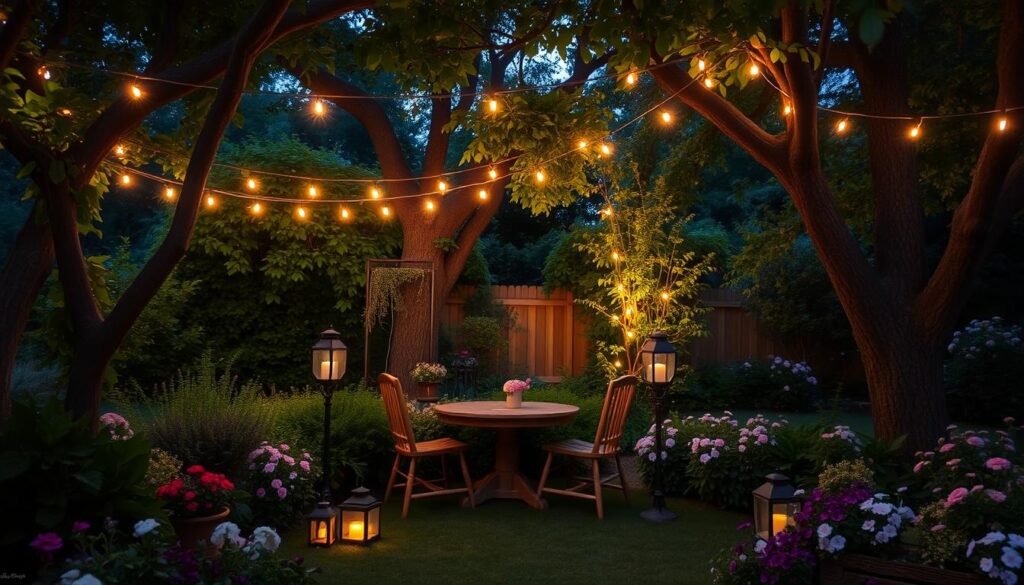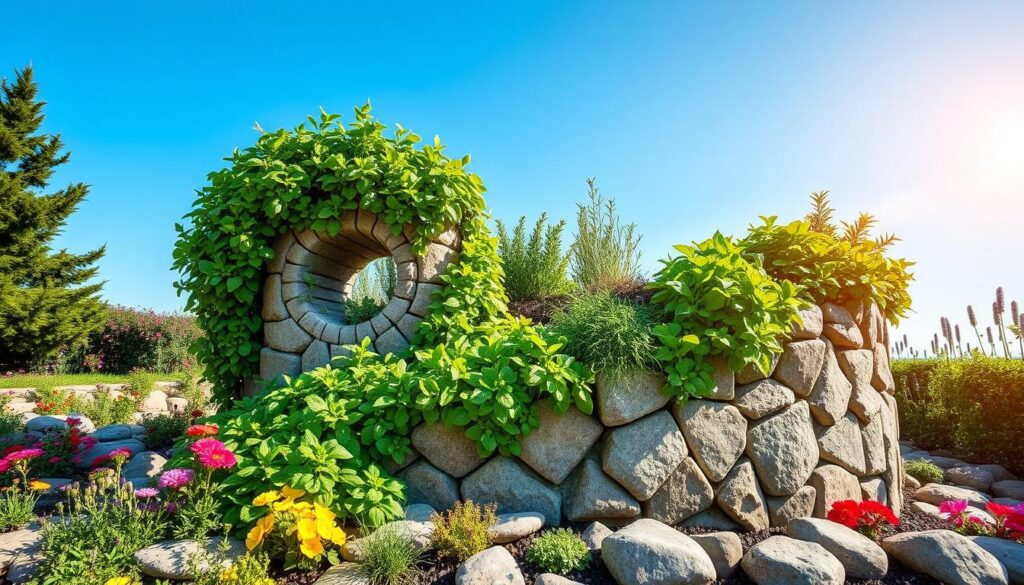Ever thought about how a few DIY garden projects could turn your outdoor area into a beautiful oasis? With a little creativity and effort, you can make your garden unique and personal. Each project not only makes your garden look better but also gives you a sense of pride.
From building raised beds to creating cozy spots, the options are endless. This article will show you how to make your garden more sustainable and joyful. It will inspire you to love your outdoor space even more.
Key Takeaways
- DIY garden projects enhance the beauty of outdoor spaces.
- Outdoor crafts allow for personal expression in garden decor.
- Emphasizing sustainability can lead to more rewarding gardening experiences.
- Backyard DIY projects can be both fun and fulfilling.
- Engaging in gardening ideas fosters a deeper connection with nature.
Create a Stunning Garden Pathway
Creating pathways in your garden can turn an ordinary space into something amazing. Thoughtful garden pathway ideas make your outdoor space both beautiful and functional. They encourage everyone to explore every corner of your garden.
Choosing the right materials is key for a pathway that looks good and lasts long. You can use stones, gravel, or reclaimed wood. These options are good for the environment too.
Choosing the Right Materials
When picking materials for your garden pathway, think about the look you want. Here are some popular choices for DIY garden projects:
- Stone: It looks natural and is very durable.
- Gravel: It’s affordable and works well for a rustic look.
- Reclaimed wood: It adds warmth and charm, and is good for the planet.
Step-by-Step Installation
Setting up a garden pathway is easy, even if you’re new to outdoor crafts. Just follow these simple steps:
- Use stakes and string to mark out the pathway.
- Dig the pathway area, making sure it’s even for your materials.
- Put down a base layer, like sand or gravel, for stability.
- Place your chosen materials neatly for a clean look.
- Fill any gaps with soil or more gravel to keep the pathway in place.
Construct Raised Garden Beds
Raised garden beds are a smart way to garden today. They improve soil and drainage and make gardening easier for everyone. This guide will help you create a beautiful backyard garden with confidence.
Benefits of Raised Beds
There are many good reasons to choose raised garden beds:
- Improved Soil Quality: You can control the soil better in raised beds.
- Enhanced Drainage: Raised beds help water drain, preventing puddles.
- Pest Control: Raised beds can keep pests away, protecting your plants.
- Accessibility: Raised beds are easier to work in, reducing strain.
Ideal Planting Techniques
Good gardening techniques are key for raised beds. Here are some tips:
- Pick plants that do well in raised beds, like herbs and veggies.
- Use companion planting to boost crop yields and fight pests.
- Plant things far enough apart for air and growth.
- Try vertical gardening to use space better.
Maintenance Tips
To keep your raised garden beds healthy, follow these steps:
- Keep an eye on soil moisture and water when needed.
- Use organic mulch to keep moisture in and weeds out.
- Check for pests and diseases often and fix problems fast.
- Change up your crops each season to avoid soil depletion.
Build an Outdoor Compost Bin
Creating an outdoor compost bin is key to sustainable gardening. It turns organic waste into soil full of nutrients. This helps your plants and cuts down on landfill waste. Composting fits well with DIY garden projects, letting you recycle kitchen and yard waste.
Why Composting is Essential
Composting is great for the environment and your garden. It:
- Reduces landfill waste, helping our planet.
- Improves soil, making plants grow better.
- Lessens the need for chemical fertilizers, supporting organic gardening.
Types of Composting Systems
There are many composting systems, each with its own benefits:
- Hot Composting: This method heats up materials fast, breaking them down in weeks.
- Cold Composting: This slower method lets materials decompose naturally over months, needing less care.
- Worm Composting (Vermicomposting): Using worms, this system turns waste into nutrient-rich fertilizer quickly.
Best Materials for Composting
To make a good outdoor compost bin, use the right materials. Here are some:
| Green Materials | Brown Materials |
|---|---|
| Vegetable scraps | Dry leaves |
| Coffee grounds | Pine needles |
| Grass clippings | Cardboard |
| Eggshells | Shredded newspaper |
Design a Relaxing Garden Retreat
Creating a garden retreat is a great way to escape into nature. It brings serenity and calmness. With Zen gardens, comfy seating, and plants for privacy, you can make a peaceful backyard. It becomes a place for leisure and reflection.
Element of Zen Gardens
Zen gardens are all about tranquility. They often have raked gravel or sand in calming patterns. These gardens have a simple look that helps you focus on the moment.
To add this to your garden, think about using stones, water features, and plants. This creates a calm space perfect for relaxing.
Incorporating Comfortable Seating
Comfortable seating is key for a great garden retreat. Hammocks, lounge chairs, or wooden benches are great choices. Pick materials that can stand up to the weather.
Place your seating in shaded areas or near flowers. This makes your space more enjoyable and comfortable.
Using Plants for Privacy
Privacy is important for a peaceful retreat. Use tall hedges, bamboo, or climbing vines to block out the outside. This makes your garden feel secluded and adds beauty to it.
Choosing the right plants can make your garden look great and private. It’s all about creating a welcoming space.
Create Engaging Vertical Gardens
Vertical gardens are a great addition to any outdoor space. They add color and make the most of small areas. Choosing the right plants is key to a thriving vertical garden.
Choosing the Best Plants for Vertical Spaces
For vertical gardens, pick plants that do well in tight spots. Some top picks include:
- Succulents: They’re easy to care for and come in many colors and shapes.
- Herbs: Like basil, mint, and parsley, they grow well vertically and are great for cooking.
- Flowering plants: Climbing types like morning glories and sweet peas add beauty.
Using these plants in your DIY vertical gardens makes your space lively and useful.
DIY Vertical Garden Structures
Building your own vertical garden structures is fun and rewarding. Here are some ideas:
- Pallet vertical gardens: Turn wooden pallets into unique gardening walls.
- Trellises: Support climbing plants to let them grow up high.
- Hanging planters: Hang plants in creative containers for an artistic look.
You can customize each structure to fit your style and needs, making the most of your gardening ideas.
Maintenance Practices
To keep vertical gardens healthy, follow these steps:
- Regular watering: Keep plants moist, especially if they’re in the sun.
- Pruning: Trim plants to keep them shaped and encourage growth.
- Fertilizing: Use organic fertilizers to help plants grow well.
Install Cozy Garden Lighting
Garden lighting is key to making your outdoor space more charming. By using different outdoor lights, you can make your garden a cozy spot for relaxation and chatting. You can choose from DIY lights or professional fixtures to make your garden magical.
Types of Outdoor Lighting
Here are some lighting options to consider:
- Solar Lights: These lights are energy-saving and easy to set up. They use sunlight to light up your garden at night.
- LED Lights: LED lights are long-lasting and versatile. They give off a bright light while using little electricity.
- String Lights: String lights add a warm feel. They’re great for hanging on fences, trees, or patios.
Placement Ideas for Ambiance
Here are some tips for placing your lights:
- Pathway Lighting: Use small lights to light up garden paths. This makes your garden safer and more beautiful.
- Accent Lighting: Use focused lights to highlight trees or sculptures. This creates beautiful night-time views.
- Dining Areas: Put lights above where you’ll be sitting. This makes sure you can see and adds to the cozy feel of outdoor meals.

Using these lighting options and smart placements can really improve your garden’s look at night. Try mixing DIY lights with professional ones to match your style.
| Type of Light | Benefits | Best Use Cases |
|---|---|---|
| Solar Lights | Energy-efficient, low maintenance | Walkways, flower beds |
| LED Lights | Long-lasting, cost-effective | General garden illumination |
| String Lights | Creates a festive atmosphere | Patios, pergolas |
Build a Simple Birdhouse
Building a birdhouse is a fun DIY project that makes your garden better. It attracts birds and brings life to your outdoor space. Plus, it helps local wildlife and teaches you woodworking skills.
Choosing Safe Materials
Choosing the right materials is key for your birdhouse project. Use untreated wood like cedar, pine, or plywood for bird safety. Stay away from pressure-treated lumber because it’s harmful.
Use nails instead of screws to avoid bird injuries. Also, pick a non-toxic wood preservative to protect your birdhouse from the weather.
Designing for Different Bird Species
Each bird species has its own nesting needs. When you design your birdhouse, keep these in mind:
- Size: Make sure the size fits the bird you want to attract.
- Entrance Hole: Choose the right hole size for different birds. For example, 1.25 inches is good for house sparrows.
- Ventilation: Add small holes at the top for air. This keeps the inside cool.
Designing for specific birds increases your chances of attracting them. It also helps local wildlife. Here’s a quick guide for common bird species and their preferences:
| Bird Species | Entrance Hole Size | Interior Dimensions |
|---|---|---|
| House Sparrow | 1.25 inches | 6 x 6 x 8 inches |
| Bluebird | 1.5 inches | 5 x 5 x 10 inches |
| Chickadee | 1.125 inches | 4 x 4 x 8 inches |
Grow a Herb Spiral Garden
A herb spiral garden is a smart way to use small spaces and follow green gardening. It lets you grow many herbs in a small area. Plus, it helps the garden by creating special spots for plants to grow.
Building a herb spiral can be very rewarding. It’s a great DIY project for garden lovers.
Benefits of Herb Spirals
Herb spirals are good for the environment. They are great for both new and experienced gardeners. Here are some reasons why:
- Improved drainage: The spiral shape helps water drain well, keeping roots healthy.
- Microclimates: Different levels offer different sunlight and moisture, perfect for many herbs.
- Space efficiency: Growing up saves space, letting you grow many herbs in a small area.
Planning and Planting Your Spiral
Planning is key for a successful herb spiral. Choose a spot that gets lots of sunlight and drains well. Here’s how to build your spiral:
- Get stones or bricks to make the spiral shape.
- Draw your spiral on the ground, making sure it’s big enough for your herbs.
- Fill it with soil, making levels for each plant to grow well.
- Pick herbs that grow well together, thinking about their sunlight and water needs.
- Plant your herbs, putting sun-loving ones at the top and shade ones at the bottom.

Unique Garden Upcycling Ideas
Upcycling makes your garden better and helps the planet. It turns old items into beautiful garden decor. This saves money and cuts down on waste. Look in your garage or shed for hidden treasures.
Repurposing Household Items
Repurposing items is rewarding in gardening. A wooden ladder can become a plant stand. Glass jars can be stylish candle holders. Even old wine bottles can water plants.
Creative Container Gardens
Container gardening is a great way to show off your upcycled items. Old tires can be painted and stacked for a fun planter. Tin cans make cute herb pots. This lets you customize your garden to your taste.
Sustainable Practices in Gardening
Sustainable gardening is more than just using what you have. It’s about being creative and resourceful. Look for eco-friendly blogs and DIY videos for ideas. Your garden should reflect your personality and help the environment.
FAQ
What are some easy outdoor projects I can start with?
Start with simple projects like painting rocks, making bird feeders, or planters from recycled stuff. These DIY projects are fun and make your garden look great.
How do I choose plants for a vertical garden?
Pick plants that do well in vertical spaces, like succulents, herbs, or trailing flowers. Make sure they get the right sunlight and moisture for a healthy garden.
What materials are best for building raised garden beds?
Cedar, redwood, or composite wood are good because they last long and don’t rot. You can also use metal or concrete blocks for stylish, functional beds.
What are the benefits of starting a compost bin?
Composting cuts down on waste and makes great soil for your garden. It’s key for sustainable gardening, improving soil health and attracting beneficial microbes.
How can I design a comfortable garden retreat?
Add cozy seating like chairs or swings. Use privacy plants and soft lighting to make it peaceful. This creates a perfect spot for relaxation.
What types of outdoor lighting work best in gardens?
Solar lights, string lights, and lanterns are great for outdoor lighting. Choose warm tones to make your garden welcoming, especially at night.
How do I create upcycled garden decor?
Look for items like old jars, bottles, or tires to upcycle. Turn them into planters or garden art. It’s a fun way to reuse and personalize your garden.
What should I consider when building a birdhouse?
Use safe, weather-resistant materials and design for local birds. Make sure it has good drainage and ventilation for a safe bird home.
Can you grow herbs in a herb spiral garden?
Yes! Herb spirals use vertical space well, allowing for different herbs to grow. They’re great for small spaces and give you fresh herbs.
What are some creative container gardening ideas?
Use wooden pallets, old crates, or even tea cups for containers. Mix plants in different containers for a colorful display that shows off your creativity.


